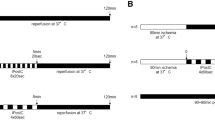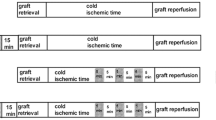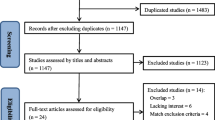Abstract
Background
Intermittent clamping (IC) and ischemic preconditioning (PC) reportedly protect the liver against the ischemia/reperfusion (I/R) injury induced by inflow occlusion during hepatectomy. While IC cycles consisting of 15 min of clamping with 5 min of reperfusion are used empirically, the optimal IC cycle has not been established. We compared the effects of various cycles of IC and PC in the rat liver.
Methods
Rats subjected to 60 min of inflow occlusion were assigned to the following five groups (n = 8 each): 60 min of continuous ischemia; 4 cycles comprising 15 min of ischemia/5 min of reperfusion; 6 cycles comprising 10 min of ischemia/3.3 min of reperfusion; 12 cycles comprising 5 min of ischemia/1.7 min of reperfusion (the time ratio of ischemia to reperfusion in the IC groups was 3:1); and PC (10/10 min of ischemia/reperfusion) prior to 60 min of ischemia. The severity of liver injury was assessed by determining the serum alanine aminotransferase (ALT) level, bile flow, tissue glutathione content, and induction of apoptosis (terminal deoxynucleotidyl transferase-mediated biotin nick end-labeling [TUNEL] staining and DNA laddering), and by histological examination of areas of severe necrosis.
Results
All the parameters indicated that liver injury was attenuated in the three IC groups compared with the continuous group; furthermore, this effect became increasingly marked with shorter cycles of IC. PC did not exert a protective effect under the present experimental conditions.
Conclusion
Various cycles of IC consistently conferred protection against I/R injury, and IC with shorter cycles of ischemia and reperfusion was more effective. No protective effect of PC was evident. IC is a more robust strategy than the PC protocol for liver protection.









Similar content being viewed by others
References
Kooby DA, Stockman J, Ben-Porat L, Gonen M, Jarnagin WR, Dematteo RP, et al. Influence of transfusions on perioperative and long-term outcome in patients following hepatic resection for colorectal metastases. Ann Surg. 2003;237:860–9.
Tsao JI, Loftus JP, Nagomey DM, Adson MA, Ilstrup DM. Trends in morbidity and mortality of hepatic resection for malignancy: a matched comparative analysis. Ann Surg. 1994;220:199–205.
Pringle J. Note on the arrest of hepatic hemorrhage due to trauma. Ann Surg. 1908;48:501.
Makuuchi M, Mori T, Gunven P, Yamazaki S, Hasegawa H. Safety of hemihepatic vascular occlusion during resection of the liver. Surg Gynecol Obstet. 1987;164:155–8.
Imamura H, Seyama Y, Kokudo N, Maema A, Sugawara Y, Sano K, et al. One thousand fifty-six hepatectomies without mortality in 8 years. Arch Surg. 2003;138:1198–206.
Man K, Fan ST, Ng IO, Lo CM, Liu CL, Wong J. Prospective evaluation of Pringle maneuver in hepatectomy for liver tumors by a randomized study. Ann Surg. 1997;226:704–13.
Kim YI, Nakashima K, Tada I, Kawano K, Kobayashi M. Prolonged normothermic ischaemia of human cirrhotic liver during hepatectomy: a preliminary report. Br J Surg. 1993;80:1566–70.
Rudiger HA, Kang KJ, Sindram D, Riehle HM, Clavien PA. Comparison of ischemic preconditioning and intermittent and continuous inflow occlusion in the murine liver. Ann Surg. 2002;235:400–7.
Camargo CA Jr, Madden JF, Gao W, Selvan RS, Clavien PA. Interleukin-6 protects liver against warm ischemia/reperfusion injury and promotes hepatocyte proliferation in therodent. Hepatology. 1997;26:1513–20.
Belghiti J, Noun R, Malafosse R, Jagot P, Sauvanet A, Pierangeli F, et al. Continuous versus intermittent portal triad clamping for liver resection: a controlled study. Ann Surg. 1999;229:369–75.
Clavien PA, Selzner M, Rudiger HA, Graf R, Kadry Z, Rousson V, et al. A prospective randomized study in 100 consecutive patients undergoing major liver resection with versus without ischemic preconditioning. Ann Surg. 2003;238:843–52.
Petrowsky H, McCormack L, Trujillo M, Selzner M, Jochum W, Clavien PA. A prospective, randomized, controlled trial comparing intermittent portal triad clamping versus ischemic preconditioning with continuous clamping for major liver resection. Ann Surg. 2006;244:921–30.
Smymiotis V, Theodoraki K, Arkadopoulos N, Fragulidis G, Condi-Pafiti A, Plemenou-Fragou M, et al. Ischemic preconditioning versus intermittent vascular occlusion in liver resections performed under selective vascular exclusion: a prospective randomized study. Am J Surg. 2006;192:669–74.
Peralta C, Closa D, Hotter G, Gelpí E, Prats N, Roselló-Catafau J. Liver ischemic preconditioning is mediated by the inhibitory action of nitric oxide on endothelin. Biochem Biopyhs Res Commun. 1996;22:264–70.
Peralta C, Hotter G, Closa D, Gelpí E, Roselló-Catafau J. Protective effect of preconditioning on the injury associated to hepatic ischemia–reperfusion in the rat: role of nitric oxide and adenosine. Hepatology. 1997;30:1223–31.
Hardy KJ, Tancheroen S, Syulkes A. Comparison of continuous versus intermittent ischemia–reperfusion during liver resection in an experimental model. Br J Surg. 1995;82:833–6.
Isozaki H, Adam R, Gigou M, Szekely AM, Shen M, Bismuth H. Experimental study of the protective effect of intermittent hepatic pedicle clamping in the rat. Br J Surg. 1992;79:310–3.
van Wagensveld BA, van Gulik TM, Gelderblom HC, Scheepers JJ, Bosma A, Endert E, et al. Prolonged continuous or intermittent vascular inflow occlusion during hemihepatectomy in pigs. Ann Surg. 1999;229:376–84.
Nieuwenhuijs VB, de Bruijin MT, Schiesser M, Morphett A, Padbury RT, Barritt GJ. Ischemic preconditioning and intermittent ischemia preserve bile flow in a rat model of ischemia/reperfusion injury. Dig Dis Sci. 2007;52:3029–37.
Jang JH, Kang KJ, Kang Y, Lee IS, Graf R, Clavien PA. Ischemic preconditioning and intermittent clamping confer protection against ischemic injury in the cirrhotic mouse liver. Liver Transpl. 2008;14:980–8.
Horiuchi T, Muraoka R, Tabo T, Uchinami M, Kimura N, Tanigawa N. Optimal cycles of hepatic ischemia and reperfusion for intermittent pedicle clamping during liver surgery. Arch Surg. 1995;130:754–8.
Miyagawa Y, Imamura H, Soeda J, Matsunaga K, Mochida S, Fujiwara K, et al. Fate of hepatocyte and sinusoidal lining cell function and kinetics after extended cold preservation and transplantation of the rat liver. Liver Transpl. 2002;8:370–81.
Peralta C, Closa D, Xaus C, Gelpi E, Rosello-Catafau J, Hotter G. Hepatic preconditioning in rats is defined by a balance of adenosine and xanthine. Hepatology. 1998;28:768–73.
Bowers BA, Branum GD, Rotolo FS, Watters CR, Meyers WC. Bile flow—an index of ischemic injury. J Surg Res. 1987;42:565–9.
Koeppel TA, Trauner M, Mennone A, Arrese M, Rios-Velez L, Boyer JL. Role of glutathione in hepatic bile formation during reperfusion after cold ischemia of the rat liver. J Hepatol. 1998;28:812–9.
Jaeschke H. Molecular mechanisms of hepatic ischemia–reperfusion injury and preconditioning. Am J Physiol Gastrointest Liver Physiol. 2003;284:G15–26.
Liu P, Fisher MA, Farhood A, Smith CW, Jaeschke H. Beneficial effects of extracellular glutathione against endotoxin-induced liver injury during ischemia and reperfusion. Circ Shock. 1994;43:64–70.
Dunne JB, Davenport M, Williams R, Tredger JM. Evidence that S-adenosylmethionine and N-acetylcysteine reduce injury from sequential cold and warm ischemia in the isolated perfused rat liver. Transplantation. 1994;57:1161–7.
Kobayashi H, Kurokawa T, Kitahara S, Nonami T, Harada A, Nakao A, et al. The effects of gamma-glutamylcysteine ethyl ester, a prodrug of glutathione, on ischemia–reperfusion-induced liver injury in rats. Transplantation. 1992;54:414–8.
Serafin A, Rosello-Catafau J, Prats N, Xaus C, Gelpi E, Peralta C. Ischemic preconditioning increase the tolerance of fatty liver to hepatic ischemia–reperfusion injury in the rat. Am J Pathol. 2002;161:587–601.
Amersi F, Nelson SK, Shen XD, Kato H, Melinek J, Kupiec-Weglinski JW, et al. Bucillamine, a thiol antioxidant, prevents transplantation-associated reperfusion injury. Proc Natl Acad Sci USA. 2002;99:8915–20.
Schauer RJ, Gerbes AL, Vonier D, op den Winkel M, Fraunberger P, Bilzer M. Induction of cellular resistance against Kupffer cell-derived oxidant stress: a novel concept of hepatoprotection by ischemic preconditioning. Hepatology. 2003;37:286–295.
Accatino L, Pizarro M, Solís N, Arrese M, Koenig CS. Bile secretory function after warm hepatic ischemia–reperfusion injury in the rat. Liver Transpl. 2003;9:1199–210.
Lawson JA, Fisher MA, Simmons CA, Farhood A, Jaeschke H. Parenchymal cell apoptosis as a signal for sinusoidal sequestration and transendothelial migration of neutrophils in murine models endotoxin- and Fas-antibody-mediated liver injury. Hepatology. 1998;28:761–7.
Jaeschke H, Fisher MA, Lawson JA, Simmons CA, Farhood A, Jones DA. Activation of caspase-3 (CPP32)-like proteases is essential for TNF-a-induced hepatic parenchymal cell apoptosis and neutrophil-mediated necrosis in a murine endotoxin shock model. J Immunol. 1998;160:3480–6.
Gujral JS, Bucci TJ, Farhood A, Jaeschke H. Mechanism of cell death during warm hepatic ischemia–reperfusion in rats: apoptosis or necrosis? Hepatology. 2001;33:397–405.
Cursio R, Gugenheim J, Ricci JE, Crenesse D, Rostagno P, Maulon L, et al. A caspase inhibitor fully protects rats against lethal normothermic liver ischemia by inhibition of liver apoptosis. FASEB J. 1999;13:253–61.
Sindram D, Porte RJ, Hoffman MR, Bentley RC, Clavien PA. Platelets induce sinusoidal endothelial cell apoptosis upon reperfusion of the cold ischemic rat liver. Gastroenterology. 2000;118:183–91.
Kang KJ, Jang JH, Lim TJ, Kang Y, Park KK, Lee IS, et al. Optimal cycle of intermittent portal triad clamping during liver resection in the murine liver. Liver Transpl. 2004;10:794–801.
Kobayashi A, Imamura H, Isobe M, Matsuyama Y, Soeda J, Matsunaga K, et al. Mac-1(CD11b/CD18) and intercellular adhesion molecule-1 in ischemia–reperfusion injury of rat liver. Am J Physiol Gastrointest Liver Physiol. 2001;281:G577–85.
Jaeschke H, Lemasters JJ. Apoptosis versus oncotic necrosis in hepatic ischemia/reperfusion injury. Gastroenterology. 2003;125:1246–57.
Schmidt-Nielsen K. Scaling: why is animal size so important? Cambridge: Cambridge University Press; 1984. p. 241.
Acknowledgments
This work was supported by a Grant-in-Aid for Scientific Research (B) (20390352) from Ministry of Education, Culture, Sports, Science and Technology and by Mitsui Life Social Welfare Foundation.
Conflict of interest
The authors do not have a financial relationship with any organization that sponsored the research. The authors also have full control of all primary data and that they agree to allow the journal to review their data if requested.
Author information
Authors and Affiliations
Corresponding author
Rights and permissions
About this article
Cite this article
Seyama, Y., Imamura, H., Inagaki, Y. et al. Intermittent clamping is superior to ischemic preconditioning and its effect is more marked with shorter clamping cycles in the rat liver. J Gastroenterol 48, 115–124 (2013). https://doi.org/10.1007/s00535-012-0613-0
Received:
Accepted:
Published:
Issue Date:
DOI: https://doi.org/10.1007/s00535-012-0613-0




